| |||||
| Decades: | |||||
|---|---|---|---|---|---|
| See also: | |||||
Events from the year 1710 in Russia (The Tsardom of Russia).
| |||||
| Decades: | |||||
|---|---|---|---|---|---|
| See also: | |||||
Events from the year 1710 in Russia (The Tsardom of Russia).
| | This section needs expansion. You can help by adding to it. (July 2016) |
| | This section needs expansion. You can help by adding to it. (July 2016) |
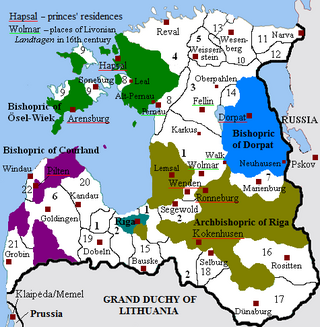
Livonia or in earlier records Livland, is a historical region on the eastern shores of the Baltic Sea. It is named after the Livonians, who lived on the shores of present-day Latvia.

The Great Northern War (1700–1721) was a conflict in which a coalition led by the Tsardom of Russia successfully contested the supremacy of the Swedish Empire in Northern, Central and Eastern Europe. The initial leaders of the anti-Swedish alliance were Peter I of Russia, Frederick IV of Denmark–Norway and Augustus II the Strong of Saxony–Poland–Lithuania. Frederick IV and Augustus II were defeated by Sweden, under Charles XII, and forced out of the alliance in 1700 and 1706 respectively, but rejoined it in 1709 after the defeat of Charles XII at the Battle of Poltava. George I of Great Britain and the Electorate of Hanover joined the coalition in 1714 for Hanover and in 1717 for Britain, and Frederick William I of Brandenburg-Prussia joined it in 1715.

The Treaty of Nystad was the last peace treaty of the Great Northern War of 1700–1721. It was concluded between the Tsardom of Russia and the Swedish Empire on 10 September [O.S. 30 August] 1721 in the then Swedish town of Nystad. Sweden had settled with the other parties in Stockholm and in Frederiksborg (1720).

Swedish Livonia was a dominion of the Swedish Empire from 1629 until 1721. The territory, which constituted the southern part of modern Estonia and the northern part of modern Latvia, represented the conquest of the major part of the Polish-Lithuanian Duchy of Livonia during the 1600–1629 Polish-Swedish War. Parts of Livonia and the city of Riga were under Swedish control as early as 1621 and the situation was formalized in the Truce of Altmark 1629, but the whole territory was not ceded formally until the Treaty of Oliva in 1660. The minority part of the Wenden Voivodeship retained by the Polish–Lithuanian Commonwealth was renamed the Inflanty Voivodeship, which today corresponds to the Latgale region of Latvia.

Field Marshal and Count Jacob Pontusson De la Gardie was a statesman and a soldier of the Swedish Empire, and a Marshal from 1620 onward.

Ingria is a historical region in what is now northwestern European Russia. It lies along the southeastern shore of the Gulf of Finland, bordered by Lake Ladoga on the Karelian Isthmus in the north and by the River Narva on the border with Estonia in the west. The earliest known indigenous European peoples of the region are the now mostly Eastern Orthodox Izhorians and Votians, as well as the Ingrian Finns who descend from the Lutheran Finnish immigrants who settled in the area in the 17th century, when Finland proper and Ingria were both parts of the Swedish Empire.

Pärnu is the fourth largest city in Estonia and third in terms of the ethnic Estonian population. Situated in southwest Estonia, Pärnu is located 128 kilometres (80 mi) south of the Estonian capital, Tallinn, and 176 kilometres (109 mi) west of Estonia's second largest city, Tartu. The city sits off the coast of Pärnu Bay, an inlet of the Gulf of Riga, which is a part of the Baltic Sea. In the city, the Pärnu River drains into the Gulf of Riga.

The Treaty of Stolbovo was a peace treaty that ended the Ingrian War, which had been fought between the Swedish Empire and the Russian Tsardom between 1610 and 1617.

The Duchy of Courland and Semigallia was a duchy in the Baltic region, then known as Livonia, that existed from 1561 to 1569 as a nominally vassal state of the Grand Duchy of Lithuania and subsequently made part of the Crown of the Polish Kingdom from 1569 to 1726 and incorporated into the Polish–Lithuanian Commonwealth in 1726. On March 28, 1795, it was annexed by the Russian Empire in the Third Partition of Poland.
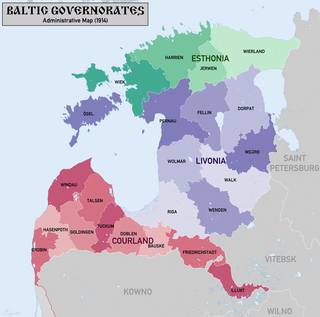
The Baltic governorates, originally the Ostsee governorates, was a collective name for the administrative units of the Russian Empire set up in the territories of Swedish Estonia, Swedish Livonia (1721) and, afterwards, of the Duchy of Courland and Semigallia (1795).

The Livonian War (1558–1583) was fought for control of Old Livonia. The Tsardom of Russia faced a varying coalition of the Dano-Norwegian Realm, the Kingdom of Sweden, and the Union of the Grand Duchy of Lithuania and the Kingdom of Poland.

Vyborg Castle is a fortress in Vyborg, Russia. It was built by the Swedes during the Middle Ages around which the town of Vyborg evolved. The castle became the stronghold of the Swedish realm in the Karelian region. Throughout the centuries, it was the first defense of the kingdom against the Russians. Its military and strategic status in the late Middle Ages was second only to the fortified capital Stockholm. Currently it serves as the site of Vyborg Regional Museum.
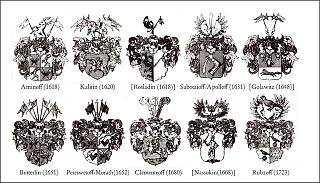
Bayors, were a group of Russian noble families who had entered Swedish service in the late 16th–early 17th centuries and were incorporated into the Swedish nobility. The word is derived from Russian Russian: бояринъ, romanized: bojarin 'boyar' and in the Swedish language of the early modern era it referred to all Russian noblemen.

With the Capitulation of Estonia and Livonia in 1710 the Swedish dominions Estonia and Livonia were integrated into the Russian Empire following their conquest during the Great Northern War. The Livonian nobility and the city of Riga capitulated on 4 July (O.S.) / 15 July 1710 (N.S.), Pernau (Pärnu) in August, and the Estonian nobility and the city of Reval (Tallinn) on 29 September (O.S.) / 10 October (N.S.). Russia left the local institutions in place and confirmed the traditional privileges of the German nobles and burghers as was established in Privilegium Sigismundi Augusti, especially with respect to the Protestant faith. The land reform of the so-called reduction which had been introduced by the Swedish king Charles XI, and transformed many serfs to subjects of the Crown, was reversed.
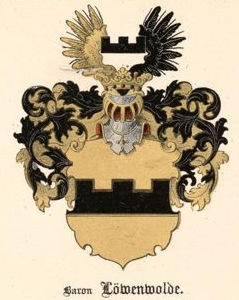
Gerhard Johann von Löwenwolde was a Baltic German Estonian knight. In the 1690s, he announced support of Johann Reinhold von Patkul's lobbyism against Swedish absolutist threats to Baltic noble privileges, while also working with the Swedish authorities in Estonia. He served in the Swedish army, and in 1697 was promoted major of the Swedish garrison in Riga. During the Great Northern War, he first served Augustus the Strong of Saxe-Poland–Lithuania, and after taking an ambiguous stance towards August and Peter the Great of Russia entered Peter's service after the Capitulation of Estonia and Livonia in 1710. He served as Peter the Great's plenipotentiary of Livonia during the same year, and held that office until 1713, when he became hofmeister in the service of Princess Charlotte of Brunswick-Wolfenbüttel, wife of Peter's son Alexei Petrovich, Tsarevich of Russia.

The Treaty of Vilnius or Vilna was concluded on 28 November 1561, during the Livonian War, between the Livonian Confederation and the Grand Duchy of Lithuania in Vilnius. With the treaty, the non-Danish and non-Swedish part of Livonia, with the exception of the Free imperial city of Riga, subjected itself to the Grand Duke of Lithuania, Sigismund II Augustus with the Pacta subiectionis (Provisio ducalis). In turn, Sigismund granted protection from the Tsardom of Russia and confirmed the Livonian estates' traditional privileges, laid out in the Privilegium Sigismundi Augusti.

The siege of Viborg took place in the spring of 1710 during the Great Northern War (1700–1721), as a second attempt by the Russians to capture the fortress port of Viborg, near the modern border between Russia and Finland, after a failed attempt in 1706. After the outbreak of the war, Swedish forces had fortified themselves in the port of Viborg. In order to assure safety for the newly founded city of Saint Petersburg, Peter the Great ordered the Swedish fort to be secured. A first unsuccessful attempt was made in 1706. Later plans were put on hold because of other ongoing conflicts but, after the Russian success at the Battle of Poltava in June 1709, the men and resources were available to capture the town.

Estonia under Swedish rule (1561–1710) signifies the period of time when large parts of the country, and after 1645, entire present-day Estonia, were under Swedish rule. In the wake of the breakup of the State of the Teutonic Order, the Baltic German local nobility in the areas of Harrien (Harjumaa) and Wierland (Virumaa), as well as the city of Reval (Tallinn) in June 1561 asked for and were granted protection by the Swedish king Eric XIV, leading to Swedish involvement in the Livonian War. At the conclusion of hostilities in 1583, Sweden was in control of the northern parts of modern Estonia and Dagö ; the Duchy of Estonia was created from this territory. Following renewed wars between Poland and Sweden, the southern parts of present-day Estonia were incorporated into Sweden by the Treaty of Altmark in 1629. Sweden also conquered the island of Ösel (Saaremaa) from Denmark, and were thus in control of all of present-day Estonia.

Trångsund Fortress is a naval fort by the Vyborg Bay in the town of Vysotsk, Leningrad Oblast, Russia. It was established by Peter the Great in 1710 to secure the town of Vyborg which was captured from Sweden during the Great Northern War.
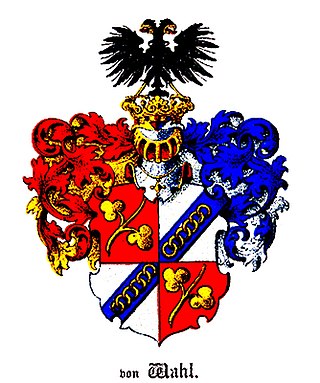
The Wahlfamily is a noble family originating in Scotland which later settled in the Baltic states.
![]() Media related to 1710 in Russia at Wikimedia Commons
Media related to 1710 in Russia at Wikimedia Commons